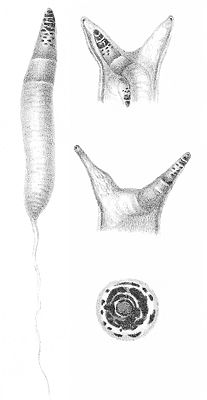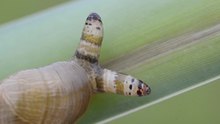Leucochloridium paradoxum
| Leucochloridium paradoxum | ||||||||||||
|---|---|---|---|---|---|---|---|---|---|---|---|---|

Leucochloridium paradoxum |
||||||||||||
| Systematics | ||||||||||||
|
||||||||||||
| Scientific name | ||||||||||||
| Leucochloridium paradoxum | ||||||||||||
| ( Carus , 1835) |
Leucochloridium paradoxum is a parasitic suction worm (class of Trematoda, subclass of Digenea) that belongs to the flatworms (platelet worms). During its development, colored banded and pulsating sporocyst tubesform in the antennae of the intermediate host , snails of the genus Succinea . These attract birds , which eat the antennae, since they mistake them for worms, and thereby become the ultimate host of the parasite .
Life cycle
Leucochloridium paradoxum lives as antennae larva in Succinea snails. In the adult stage it lives as urogonimus macrostomus in the cloaca or the bursa fabricii (a lymphatic organ) of various bird species. The eggs of the suction worm, which are surrounded by a hard shell, get into the environment with the feces .
The snails become infected by eating bird droppings infected with eggs.
In an alternative route of infection, the eyelash larvae ( miracidia ) hatch in the feces and infect the snail via the eye stalk. The larvae migrate from the snail's digestive tract to the midgut gland, where they transform into cercariae . Asexual reproduction creates hundreds of cercariae, which develop into sporocysts in the liver . The sporocysts collect in long tubes and form brood sacs, also known as sporocyst tubes. One or more sporocyst tubes extend through the whole body of the snail into the antennae. This increases the size of the feelers enormously, creating a colorfully banded and pulsating feeler maggot . L. paradoxum changes the behavior of the snail in such a way that it shows a higher mobility and finds itself on clearly visible, well-lit leaves. The caterpillar-like color and movement in the antennae (see video below) attracts birds that view the antennae as food. Due to the size of the feelers, the snail is no longer able to pull them in. In the bird's digestive tract, the cercariae develop into adult animals. These reproduce sexually in the cloaca and lay eggs, which in turn are excreted in the feces.
morphology
The differentiation of the Leucochloridium species is not easy due to their strong similarities. Many adults lack a hard structure and vary in size. Leucochloridium species are differentiated on the basis of their sporocyst tubes. The L. paradoxum sporocyst tubes have green bands with dark brown and black spots. During its development, the parasite takes on various sizes and shapes.
L. paradoxum has brown eggs with an oval shape. The miracidia are transparent at the beginning of their development and have an elongated shape. When the miracidia are ready to be transmitted, they infect the snail through the eye stalk. Alternatively, the eggs are eaten by snails and hatch in the snail's intestines. After the miracidia have penetrated the snail and transformed into sporocysts, they form the antennae larva. This can be recognized as a green, yellow and red pulsating brood tube with sporocysts inside. The sporocysts develop into cercariae with a locomotor system and digestive tract, which is lined by an excretory bladder that extends into the tail. The tail of the Cerkarie has fin folds on its top and bottom. There are setae on the sides of the tail. The cercaria have two eye points. At the end of the cycle, L. paradoxum is in the worm stage, called Urogonimus macrostomus . At this stage the worm is flattened dorsally and has suction organs, which are essential for adherence to the bird's intestinal wall.
Habitat
L. paradoxum lives in humid areas, for example North American or European forests, where their main hosts are various insectivorous birds (e.g. corvids, woodpeckers and finches), and intermediate hosts , snails of the genus Succinea .
Distribution area
Leucochloridium paradoxum was first discovered in Germany. Other locations are: Norway and Poland.
credentials
- ↑ Wesenberg-Lund, C. (1931). Contributions to the development of Trematoda Digenea. Part I. The biology of Leucochloridium paradoxum . D. Kgl. Danske Selsk. Skrifter, Nauturvidensk og Mathem . Afd. 9, Raekke 4: 90-142.
- ↑ a b W. Wesoowska, T. Wesoowiski, Journal of Zoology (October) 2013. Do Leucochloridum sporocysts manipulate the behavior of their snail hosts? August 2013 . Journal of Zoology. Issue 292, 2014: 151-5.
- ↑ a b T. A. Bakke (April) 1980. A revision of the family Leucochloridiidae Poche (Digenea) and studies on the morphology of Leucochloridium paradoxum Carus, 1835 . Systematic Parasitology, Volume 1, Numbers 3-4. 189-202.
- ^ Schmidt, GD (2000). Foundations in Parasitology, 6th ed. McGraw-Hill Comp.
- ^ Halík, L. (1931). About the rhythmic movements of the sporocyst tubes of Leucochloridium macrostomum Rud, which parasitize amber snails . (= paradoxum Carus ). Z. see Physiol. 14 , 462-478.
- ↑ Wesenberg-Lund, C. (1931). Contributions to the development of Trematoda Digenea. Part I. The biology of Leucochloridium paradoxum . D. Kgl. Danske Selsk. Skrifter, Nauturvidensk og Mathem . Afd. 9, Raekke 4: 90-142.
- ↑ Fried, B. (1997). Advances in Termatode Biology . Boca Raton: CRC Press.
- ↑ SP Casey, TA Bakke, PD Harris & J. Cable (November) 2004. Use of ITS rDNA for discrimination of European green- and brown-banded sporocysts within the genus Leucochloridium Carus, 1835 (Digenea: Leucochloriidae) . Systematic Parasitology. Volume 56, Number 3: 163-168
Web links
literature
- Kathleen McAuliffe: This is your brain on parasites, Houghton Mifflin Harcourt, Boston

